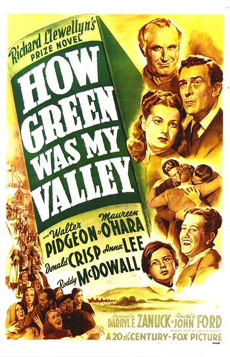It's somewhat amazing this film ever got made. The production ran into
a number of difficulties, chief among them the German bombing of the
Welsh countryside, which prevented the filmmakers from shooting on location.
Instead, they filmed in California, where they had to shoot in black
and white to disguise the fact that the hills were not nearly as green
as they had been in Wales.
You would never know, watching this film, that they had sacrificed
anything. Cinematography is one of the strengths of the movie, with
loving landscapes of the bucolic countryside and the little village
that is home to the Morgan family.
The movie borrows much of the narration from the book, which is used
in a heavy-handed fashion, as a pervasive voice-over from Huw, grown
up and recounting the days of his youth. He recalls how his simple,
happy childhood became complicated as his valley fell on harder times.
As you might imagine, he remembers those early days with the golden
halo of memory.
It's not long, however, before leisurely strolls in the countryside
with his father give way to trouble at the coal mine, the rising necessity
of organized labor, and frustrations in love for Huw's older sister,
played by Maureen O'Hara, plus several other family trials and hardships.
Through it all, the family endures, relying on each other for strength,
even as the years roll by and the household shrinks, leaving only Huw
and his parents.
The effects of World War II made a lasting impact on the film in more
than one way. Because of the German blitz, America got its first glimpse
of Roddy McDowall, who plays Huw, the youngest Morgan son. Along with
other child actors, McDowall was evacuated from England for his safety
and so was available to be cast for this movie. Huw is the heart of
the film, the character through which all the action is viewed. While
he spends much of the movie in a sort of wide-eyed fugue state, McDowall's
performance is one of the most riveting aspects of the film.
Ironically, I was recently watching an episode of Frasier in
which the stuffy Dr. Frasier Crane goes to the video store with the
express goal of renting How Green Was My Valley. Upon viewing
the film, I can imagine why Frasier would have liked it: the movie is
loaded with the sort of overblown, flowery rhetoric that Frasier himself
favors. It's about an important subject: namely, how the growth of industry
affected the working class and led to organized labor. Furthermore,
the artistry of the film's cinematography would have delighted him.
And of course, most important, the movie is obscure, something that
the hoi polloi would not rent.
Are those enough reasons to add it to your Netflix queue? Perhaps,
if like Frasier, you like florid language and melodrama. Perhaps not,
if you prefer more realistic dramas.
In many ways, this movie bears similarities to the 1940 movie The
Grapes of Wrath, also based on a novel (this one by John Steinbeck),
which told the story of an American family of sharecroppers. It, too,
relied on melodrama to cement a story about the importance of the labor
movement. As such, How Green is My Valley can be viewed as an
artifact of the time, as public awareness of the labor movement was
growing.
While the story can be a bit sprawling, it retains much more focus
than similar movies about families (such as Cimarron). The film
also contains a good deal of choral singing, as the villagers, it would
appear, quite naturally sing folk songs in multi-tiered harmony worthy
of any stage. That could be another appeal, if you enjoy music in movies.
For the time period in which it was made, How Green Was My Valley
was a well-crafted film, making important stands. Viewed through
the golden glow of history, it was a bold, artistic endeavor, even if
modern audiences may find it slow-moving and naive.
Rating (out of 5): ***
Musings
on Best Picture Winners


